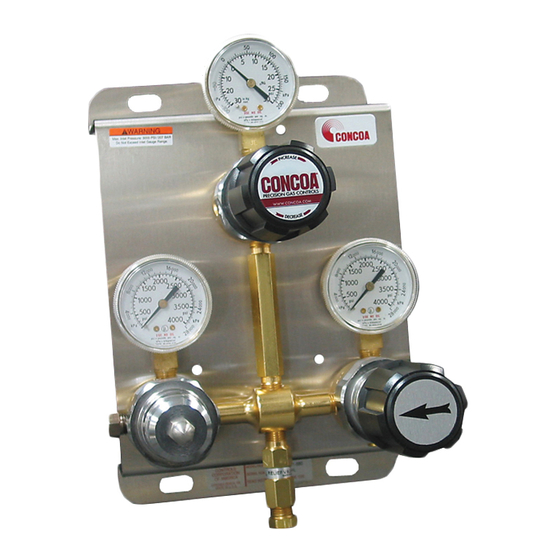Concoa 526 **3 Series Panduan Petunjuk Pemasangan dan Pengoperasian - Halaman 11
Jelajahi secara online atau unduh pdf Panduan Petunjuk Pemasangan dan Pengoperasian untuk Alat Ukur Concoa 526 **3 Series. Concoa 526 **3 Series 17 halaman. Automatic switchover system for use with non-toxic and non-corrosive gases in high purity applications

valve and any other valves that connect the cylinder to the system. The full, replacement cylinder is now
the reserve cylinder. Note: while changing cylinders on one side, there will be no interruption in fl ow. A
depleted cylinder will have the following gas pressure remaining:
MODEL NUMBER
526 2X0X
526 3X0X
526 4X0X
526 5X0X
526 7X0X
Gas will continue to fl ow from the primary side until the outlet pressure of the preset regulator matches
the pressure of the priority valve regulator. (The pressure setting of the priority valve regulator changes
when the knob is turned 180°). When the gas pressure stops dropping on the preset regulator and starts
to drop on the priority valve reg u la tor, it is time to change the left cylinder. The knob is rotated 180° to
the right before the left cylinder is changed. It is helpful to maintain a log of cylinder pressure, noting
which direction the arrow is pointing on the priority valve. When the pressure gauge is very low and the
reserve side indicates that gas has begun to fl ow from the reserve cylinder, it is time to rotate the knob
and attach a full cylinder in reserve.
If the knob is not rotated before the empty cylinder is changed, two things can happen. First, gas may fl ow
from the changed cylinder to the existing cylinder. This is because the pressure setting of the regulator on
the primary side allows the regulator main valve to remain open. Second, when the cylinder is changed,
gas will begin to fl ow from the new cylinder, stopping fl ow from the existing cylinder. This means the
existing cylinder may be partially empty. After several cycles, it is possible that the reserve cylinder may
empty shortly after a switchover occurs. Always remember to rotate the knob on the priority valve regulator
before changing a depleted cylinder.
MAINTENANCE
On regular intervals, the system should be checked for leaks and proper function (see trouble shooting). Any
leaks in the system should be corrected immediately. The pigtail check valve should also be checked for
leaks when a depleted cylinder is removed. NOTE: the system inlet and pigtail should be pressurized
when checking for leaks. At no time should the preset reg u la tor's or priority valve reg u la tor's pres sure
settings be changed.
TROUBLE SHOOTING
Typical symptoms listed below indicate regulator malfunctions needing repair. Replace immediately with
a clean, repaired and tested, or new system.
1. Gas leakage at the line regulator outlet when the adjusting screw of the line regulator is completely
backed out.
2. With no fl ow through the system (downstream valves closed and adjusting screw in) line pressure
steadily increases above set pressure.
3. Gas leakage from spring case (adjusting screw/knob end off regulator).
4. Gas leakage from any joint.
5. Excessive drop in working pressure with regulator fl owing gas.
6. Gas leakage from relief valve.
7. Gas leakage from gauge
8. Gauge does not return to zero when not under gas pressure
9. Gauge does not consistently repeat the same reading.
10. The system makes a noise or hums.
OUTLET PRESSURE (without Line Regulator)
35-95 PSIG
65-135 PSIG
160-235 PSIG
445-545 PSIG
120-185 PSIG
2.4-6.5 BAR
4.5-9.3 BAR
11-16.2 BAR
30.7-37.6 BAR
9.0-12.8 BAR
11
